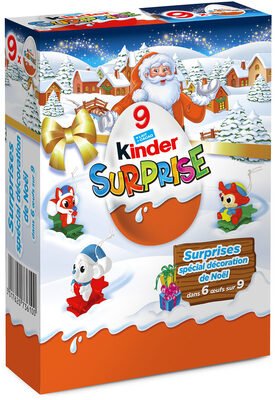Kinder surprise t9 boite de 9 œufs - 180 g
This product page is not complete. You can help to complete it by editing it and adding more data from the photos we have, or by taking more photos using the app for Android or iPhone/iPad. Thank you!
×
Some of the data for this product has been provided directly by the manufacturer FERRERO FRANCE COMMERCIALE.
Barcode: 3017620736100 (EAN / EAN-13)
Common name: KINDER SURPRISE : Confiserie recouverte de chocolat supérieur au lait contenant une surprise dans une capsule plastique
Quantity: 180 g
Packaging: Box, Cardboard, fr:Papier aluminium
Categories: Snacks, Sweet snacks, Cocoa and its products, Festive foods, Chocolates, Chocolate molds, Milk chocolates, Easter food, Chocolate eggs, Easter eggs, Hollow chocolate eggs
Labels, certifications, awards:
FSC, FSC Mix, fr:FSC C021399
Traceability code: FSC-C021899
Stores: Carrefour Market
Countries where sold: France
Matching with your preferences
Environment
Carbon footprint
Packaging
Transportation
Threatened species
Other information
Conservation conditions: A conserver au sec et à l'abri de la chaleur
Customer service: CS90058 76136 MONT-SAINT-AIGNAN
Report a problem
Data sources
Product added on by tacite
Last edit of product page on by mylabelcontributors.
Product page also edited by desan, ferrero, org-ferrero-france-commerciale, packbot, roboto-app, sebleouf, yuka.UUxrY0l2USsrZWNZZzlzMTQwNzIxc3h3blp5eFpVNjhjdlVWSVE9PQ.








